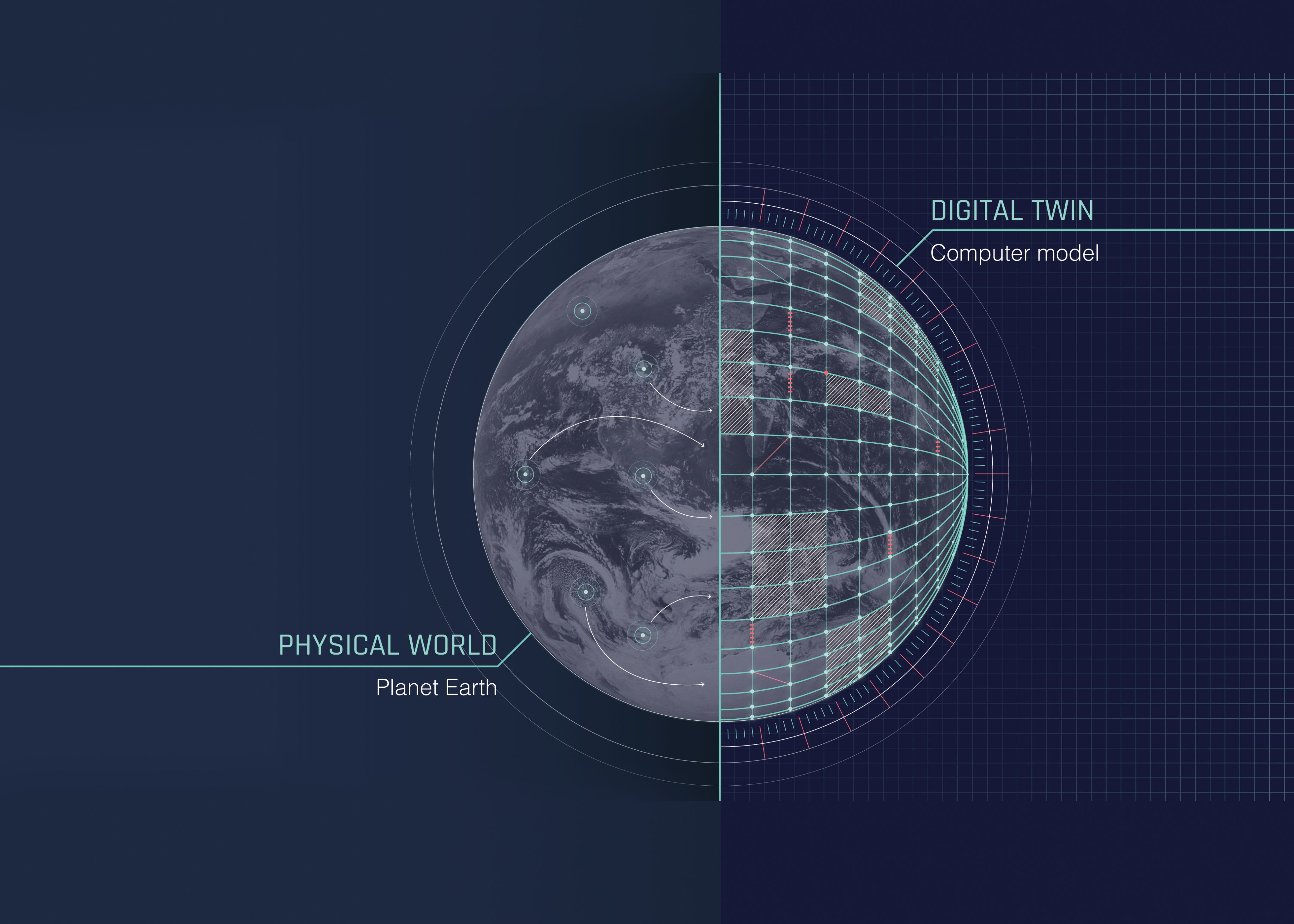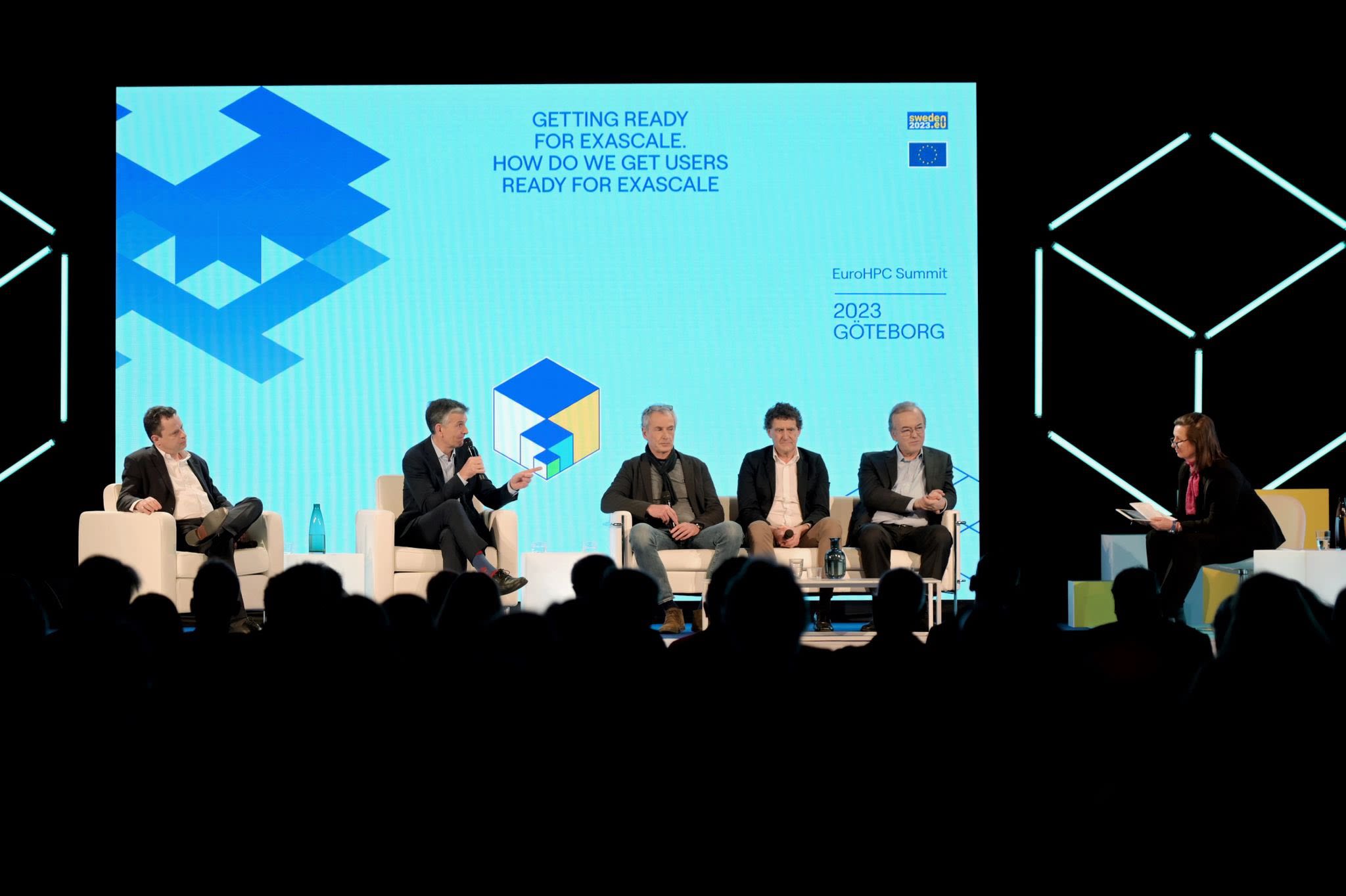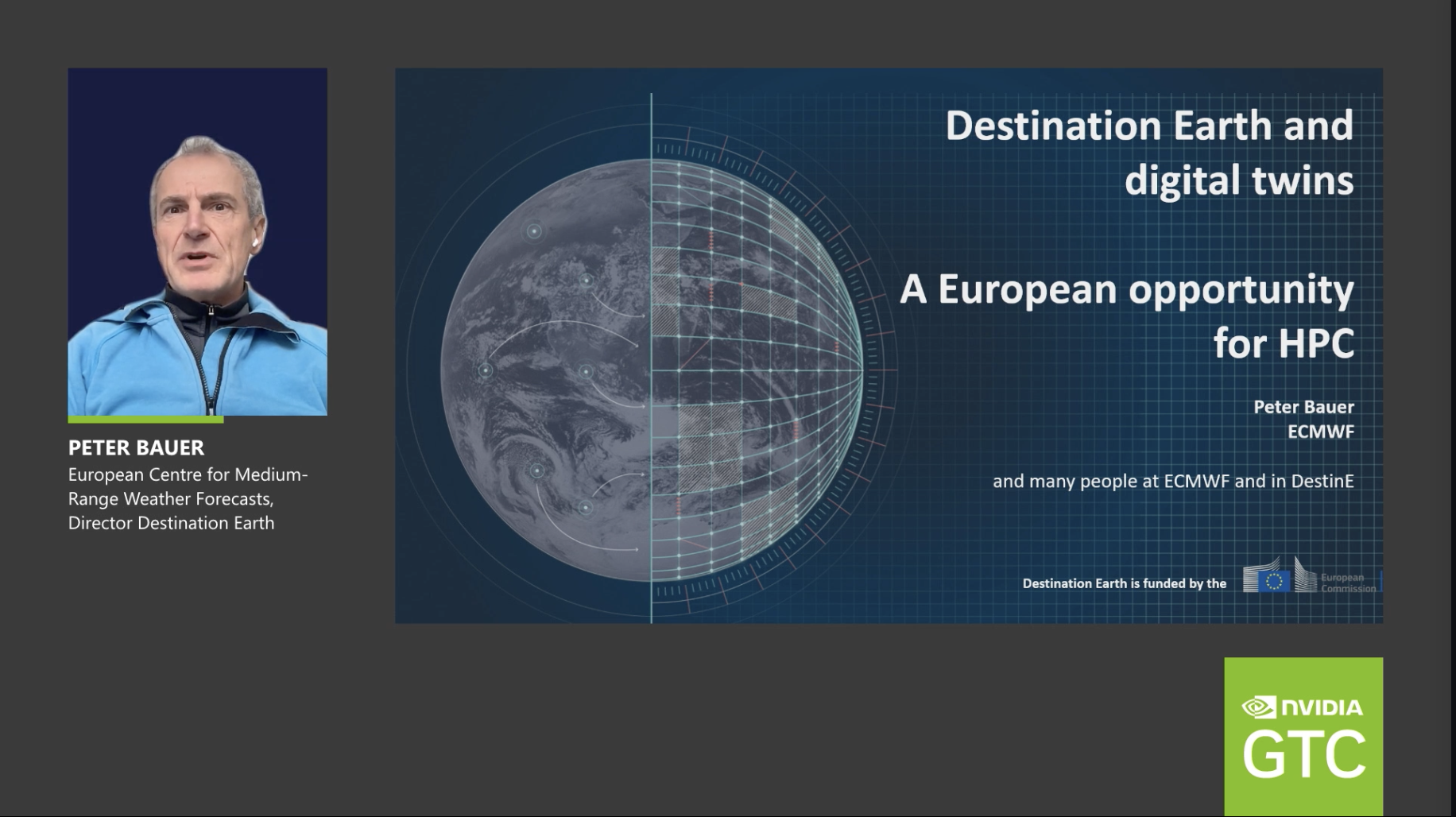Leads of ECMWF deliver Destination Earth messages at key European forums

Back to ECMWF - Destination Earth main page
The European Centre for Medium-Range Weather Forecasts (ECMWF) introduced Destination Earth activities at several key science and technology events on the week of 20 –24 March 2023. Director-General Florence Rabier, travelled to Brussels for the European Environment Agency’s conference, Peter Bauer, Director for Destination Earth at ECMWF and Thomas Geenen, Technology Partnerships Lead, explained the computing stakes at the EuroHPC JU Summit in Goteborg. Peter Bauer also presented at the NVIDIA GTC Developer Conference, a major global gathering for everything AI, accelerated computing and Metaverse.
The European Environment Agency (EEA) organised its European environment network conference with a focus on “Delivering the European Green Deal in unprecedented times.”

A view of the panel with, from left to right, Tanja Suni (Finland’s Ministry of Environment), Alberto Arribas (Microsoft), Florence Rabier (ECMWF) and Stephen Quest (JRC). Credit: EEA
A view of the panel with, from left to right, Tanja Suni (Finland’s Ministry of Environment), Alberto Arribas (Microsoft), Florence Rabier (ECMWF) and Stephen Quest (JRC). Credit: EEA
From numerical weather prediction to Copernicus and Destination Earth
Florence Rabier opened the discussion by explaining how ECMWF’s more than 40 years' experience providing medium-range weather forecasts for its member states led to the Centre operating the Copernicus Climate Change and the Copernicus Atmosphere Monitoring Services on behalf of the EU.
Continuing, she detailed how this background in monitoring the Earth system and forecasting its evolution had laid the foundations for a new generation of information systems such as the digital twins provided for DestinE.

Florence Rabier during the panel with Alberto Arribas (left) Credit: EEA
Florence Rabier during the panel with Alberto Arribas (left) Credit: EEA
Dr Rabier described how Destination Earth will produce some 1 petabyte of information a day, compared to 130 terabytes per day delivered to users for the Copernicus services implemented by ECMWF. She then explained how this enormous amount of data will be made available to users with an unprecedented level of interactivity.
The future information systems depend on partnerships
Partnerships at all levels are widely seen as a necessary step towards the information systems of the future that will enable fast, detailed and tailored access to ever-increasing volumes of information. In addition to supporting the green transition, this process will be a major shift in Europe’s digital capabilities.
“Strategic partnerships are at the core of our work,” said Florence Rabier, “I want to emphasize that the partnership with the EEA is very strong. We are already developing platforms together, such as the European Climate Data Explorer, which is part of Climate Adapt. We are also working together with the JRC in respect to floods and wildfires and of course, we have knowledge, tools and data we can export to the broader world.”
The morning session’s highlight was a keynote speech by Hans Bruyninckx, outgoing Executive Director of the European Environment Agency. Members of the European Central Bank, United Nations Development Programme, European and national environmental agencies shared the stage throughout the day.
Frans Timmermans, Executive Vice-President of the European Commission Leading the European Green Deal, closed the conference calling to pull out all the stops in data and environmental sciences in order to avoid the most catastrophic consequences of climate change, while there’s still time.
Watch the recording of the full conference here.
EuroHPC, supporting European leadership in high performance computing
The EuroHPC JU (European High Performance Computing Joint Undertaking), an initiative of the EU, European countries and private partners to develop a World Class Supercomputing Ecosystem in Europe, celebrated its annual EuroHPC Summit on 20-23 Monday and invited Peter Bauer and Thomas Geenen to speak about DestinE which largely relies on the access to extreme scale computing capabilities granted by EuroHPC.
The EuroHPC Summit is a unique yearly occasion to sound out the state of the European supercomputing ecosystem.
EuroHPC has a strict system of distribution of the computer resources following strategic priorities. Anders Dam Jensen, Executive Director of EuroHPC, explained during his talk on Tuesday that Destination Earth has been granted special access to EuroHPC supercomputers after a rigorous selection process.
“In our regulations we have the ability to grant special access to projects that are seen to be strategic for the European Union. One project made it through that screening, and that’s Destination Earth. So, on four machines, Leonardo, LUMI and the upcoming MareNostrum5 as well as Meluxina, Destination Earth has a special access with permanent access to the machines.” said Jensen.
The decision endorsed by EuroHPC JU Governing Board means that DestinE is granted 50% of the total EuroHPC resources for Strategic Initiatives, meaning 5% of the EuroHPC computing time on the three requested systems, LUMI, Leonardo and MareNostrum5.
A new type of information system for unprecedented challenges
Thomas Geenen, Technology Partnership Lead for Destination Earth was invited to the parallel panel session “Paving the Path for Digital Twins in HPC” together with members of the Jülich Supercomputing Centre (Germany) the Finnish CSC - IT Center for Science and other scientists from several disciplines.
Director for Destination Earth at ECMWF Dr. Peter Bauer participated in the panel “Getting Ready for Exascale: How do we get users ready for exascale” with guests ranging from academia, private sector and supercomputing centers.

A view of the panel discussion with, left to right: Philippe Notton (SiPearl), Sergi Girona, (Barcelona Supercomputing Center (BSC), Dr. Peter Bauer (ECMWF Destination Earth), Prof. Allen D. Mallony (University of Oregon), Prof. Dr. Dr. Thomas Lippert (Jülich) and moderator Josephine Wood. Credit: EuroHPC JU
A view of the panel discussion with, left to right: Philippe Notton (SiPearl), Sergi Girona, (Barcelona Supercomputing Center (BSC), Dr. Peter Bauer (ECMWF Destination Earth), Prof. Allen D. Mallony (University of Oregon), Prof. Dr. Dr. Thomas Lippert (Jülich) and moderator Josephine Wood. Credit: EuroHPC JU
Dr. Bauer started by describing why Destination Earth is needed. “The future climate threats, and in particular weather extremes, require quite urgent and invasive measures. We probably must build dykes, we may have to evacuate certain areas... We need to prepare ourselves in order to restructure our entire way of living. And you need information that guides you in making these crucial decisions.”
Comparing the future information system to a sort of ChatGPT at which we can ask questions such as “What is the risk of coastal flooding in Sweden for 2050?” and “What is the most cost-effective adaptation scenario?” Peter Bauer explained that DestinE, instead of the rather limited answers of the now famous artificial intelligence model, will provide several layers of information with different abstraction levels (societal, about the Earth system, data, information, and insights) suitable for different users and with different levels of interactivity at each stage.

A moment of Peter Bauer's talk during the EEA conference. Credit: EEA broadcast. Screenshot.
A moment of Peter Bauer's talk during the EEA conference. Credit: EEA broadcast. Screenshot.
Watch the conference on the EuroHPC event website. (Peter Bauer’s talk starts at 20’ of the second video of the day).
Earlier in the week Peter Bauer gave a keynote speech about Destination Earth’s digital twins at the German Physical Society annual conference, followed by over 1.000 participants.
Destination Earth at the cutting edge NVDIA GTC Developer Conference
Peter Bauer also explained the computing challenges of DestinE at the NVIDIA GTC (GPU Technology Conference) Developer Conference taking place between 20-23 March, a global reference when it comes to accelerated computing, artificial intelligence and metaverse organized by the leading manufacturer of graphics processing units now excelling in artificial intelligence.
The conference has an overwhelming program with more than 650 sessions. The DestinE director for ECMWF was invited to explain the HPC challenges and needs for DestinE in a series of talks about the role of accelerated computing in climate prediction and mitigation.
On his 45 minutes talk Peter Bauer reviewed the history of DestinE from the ECMWF’s Scalability Programme started in 2014 and even earlier with ECMWF’s World Modelling Summit for Climate Prediction, and the first European initiatives.
The current information systems work as a waterfall, Dr Bauer said, where a well-established chain of climate information is delivered from the science level to the user. “In this logic, user comes in only at the end. (...) That’s an issue, because it’s not providing exactly what the user needs. DestinE aims at going towards a user centric structure, where the user request generates the information, with a higher level of interaction, and this at all stages of the information delivery process.”
The key element of this user centric information system are the digital twins which will provide more realistic simulations at all levels: global, local and where the impacts are taking place, all this with full traceability of data sources, and uncertainties, so the user knows exactly what information is being provided for which levels of quality.

Peter Bauer’s talk for NVIDA GTC. Credit: NVIDIA GTC. Screenshot.
Peter Bauer’s talk for NVIDA GTC. Credit: NVIDIA GTC. Screenshot.
ECWMF focuses on increasing the simulations’ resolution, adapting the codes to the variety of HPC software and hardware while moving forward in the interactivity aspect and the portability, which is key to making the future system interoperable in any supercomputing environment, as well as between the different digital twins and other applications. The leads for DestinE’s computing at ECMWF published a paper in Nature describing the technology needs of the future system. https://www.nature.com/articles/s43588-021-00023-0
During the talk, Dr. Bauer mentioned the tests on exascale computers such as Summit in the USA, while wishing for an enlargement to international computing partners such as hosts NVIDIA.
Bauer also presented the current and future data handling architecture of DestinE and the machine learning elements, that will make possible some simulation operations that are currently out of reach.
The presentation finished by summarising his vision for the key features that will make Destination Earth a new paradigm leading to common thinking about solutions:
- A new information system based on Digital Twins
- Supported by state-of-the-art physics-based models and observations
- In symbiosis with advanced machine learning methods
- Using generic software infrastructures, when possible, to maximize interoperability
- User-centric with a focus on the real impacts for society
- Portable, using distributed (public-private) hardware infrastructures
- In an international collaboration framework
Watch the conference (Under registration).
Destination Earth is a European Union funded initiative launched in 2022, with the aim to build a digital replica of the Earth system by 2030. The initiative is being jointly implemented by three entrusted entities: the European Centre for Medium-Range Weather Forecasts (ECMWF) responsible for the creation of the first two ‘digital twins’ and the ‘Digital Twin Engine’, the European Space Agency (ESA) responsible for building the ‘Core Service Platform’, and the European Organisation for the Exploitation of Meteorological Satellites (EUMETSAT), responsible for the creation of the ‘Data Lake’.
We acknowledge the EuroHPC Joint Undertaking for awarding this project strategic access to the EuroHPC supercomputers LUMI, hosted by CSC (Finland) and the LUMI consortium, Marenostrum5, hosted by BSC (Spain) Leonardo, hosted by Cineca (Italy) and MeluXina, hosted by LuxProvide (Luxembourg) through a EuroHPC Special Access call.
More information about Destination Earth is on the Destination Earth website and the EU Commission website.
For more information about ECMWF’s role visit ecmwf.int/DestinE
For any questions related to the role of ECMWF in Destination Earth, please use the following email links:
